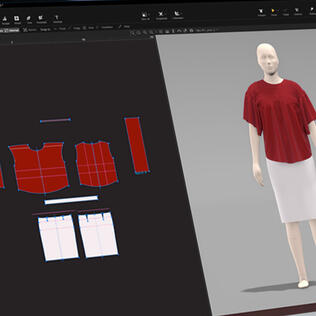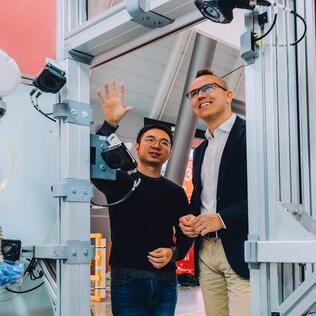An AI assistant for everyone: On developing and using ogGPT

GenAI and Large Language Models will have a comprehensive impact on our daily work life. However, public AI assistants like ChatGPT often cannot be used responsibly in a work context. Therefore, teams from the Otto Group have developed their own data protection-compliant tool, ogGPT, in a very short time. Florian Leuerer and Arne Vogt answer our questions about the development process and the experiences of the first users in our interview.
AI assistants like ChatGPT have the potential to optimize workflows and significantly increase efficiency in day-to-day business. However, in practice, there are challenges, including data protection, which significantly restrict their use in the workplace. In order to fully exploit the extensive possibilities of artificial intelligence, a cross-functional team from Otto Group IT and the Digital & Consulting department has now developed ogGPT. In the first week alone, thousands of employees from the Otto Group have tested the new tool and found initial use cases for their work.

Professional Expert Machine Learning, Otto Group IT

Product Lead Search
OTTO
Florian, ChatGPT could already be used by colleagues in the Otto Group based on out internal guidelines. Why did you take it a step further and develop the in-house ogGPT?
Florian: ChatGPT was indeed a breakthrough in the AI world and inspired us to think about ways to make this technology accessible to our colleagues in the Otto Group. However, we didn't want to just offer a ChatGPT clone, but rather create an in-house solution tailored specifically to our needs. Our goal was to make our data and systems accessible through large language models and support all employees and teams in their daily work. However, we always focused on security and data protection. With ogGPT, we have full control over the data and can ensure that all data protection requirements are met.
How was the development process?
Florian: The development of ogGPT was an iterative process that we were able to complete in two months. The individual components for ogGPT were created through various projects, proof of concepts, and hackathons that we further developed and refined over time. When we got the "go" for the company-wide rollout, the biggest challenge was to build a scalable and reliable solution from these components that could be used by over 26,000 colleagues. This required extensive testing and optimization to ensure that the system performs well, remains stable, and is secure under real conditions.
The biggest challenge was to build a scalable and reliable solution from these components.
Arne, what was your initial reaction when you heard about ogGPT? Had you previously experimented with ChatGPT or other generative AI tools?
Arne: I was pleasantly surprised because I hadn't heard about this project before. I had already been quite involved with ChatGPT since it came on the market. Primarily because I wanted to assess how it could make my work easier. Additionally, as a product manager, I have to keep an eye on the market, and such technological innovations can also be important for our product development. I experimented with various use cases using prompts and temperature to get an impression of the capabilities and limitations of the models. Temperature is a setting parameter that affects the weighting of creativity in the tool's responses.
And how did you approach the tool? What were your first steps?
Arne: I started by playing around with it a bit and then participated in a MySession, our internal training format by colleagues for colleague, because I had some specific questions, for example about APIs and data protection. The MySession was very helpful for that. Then I focused on uploading documents into my own projects and extracting information from them, as that is the major advantage compared to ChatGPT in the market.
I see potential use cases for ogGPT primarily in knowledge management.
How could ogGPT change your daily work? In which tasks and topics would you like to use the tool and how?
Arne: I see potential use cases primarily in knowledge management. We are responsible for search on otto.de and work heavily on testing and research, which generates a lot of data. Since we work in multiple teams, it is difficult to get an overview of the existing insights. ogGPT could summarize all the existing insights on a specific topic or even connect various topic areas using a prompt. Since the model also provides source references, it would be the perfect way to access this knowledge with very little effort. Especially at the start of a discovery, which is the phase in product development where we work to understand the problem and generate possible solutions, this would drastically increase efficiency. This is a use case that I would like to test in the medium term.
Florian, what's next for ogGPT? What features are you currently working on and what is on the medium-term roadmap?
Florian: We are continuously working on improving the system and adding new features. In the short term, we plan to make smaller adjustments to provide users with extended configuration options. This includes individual prompts and parameters for the models, as well as simplifying the document upload process.
In the medium term, we have larger features on our roadmap. An important focus is on improving teamwork. We want to develop features that promote collaboration within teams and enable the shared use and editing of knowledge bases. Furthermore, we plan to integrate additional generative AI features into ogGPT, such as image generation and the integration and synchronization of external data sources. This will make ogGPT even more versatile and powerful.







